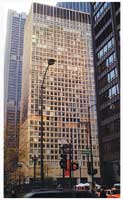 |
The 11-month study outlines 81 administrative failures that led to six deaths and 13 injuries in the "typical" office fire. "We were critical of just about everybody," says James Lee Witt, chairman of the eponymous Washington, D.C.-based firm that produced the study.
The report blames Illinois fire officials for underestimating their authority to enforce the state code in Chicago. It also faults the city for promulgating a fire code "less stringent" than the state code. "We strongly encourage that there be a harmonization of codes," says Ed Comeau, Witts operations chief.
In July, a Cook County probe concluded that automatic sprinklers, lacking in the tower, would have saved lives (ENR 7/19 p. 12). The Witt report agrees, adding that inconsistencies between state and local codes set the stage for tragedy.
In 1975, Chicago started requiring new office high-rises to have sprinklers. The state code requires sprinklers or the engineered equivalent in all high-rises.
 |
| Smoke Flow. Fatalities in Cook County building in Chicago occurred in the smoky stairwell, which had automatically locking doors. (Image above and top courtesy of James Lee Witt Associates/NIST) |
A statewide code has been talked about "for a long time," says Dave Urbanek, manager of building codes and regulations for the states Capital Development Board. A state task force report on code problems is due out in January. An earlier task force, created 10 years ago, came back with "inconclusive" answers, Urbanek says.
That is, in part, because the code game often is a "political football," says David Collins, president of code consultant The Preview Group Inc., Cincinnati.
At the county building, automatically locking exit doors trapped victims in a smoky stairwell. Firefighters, who allegedly told victims to go up, not down, created a "toxic environment" by attacking the blaze from the stairwell, allowing smoke to escape. Offices lacked compartmentation and poorly maintained smoke vents were ineffective, the report says.
Civil litigation is pending against the city, county and two facility managers.
|

Post a comment to this article
Report Abusive Comment